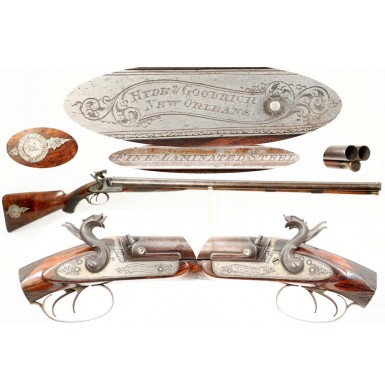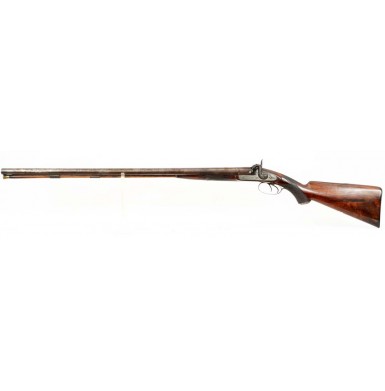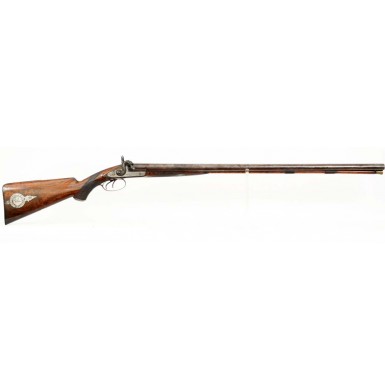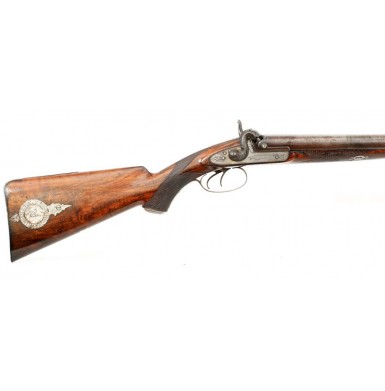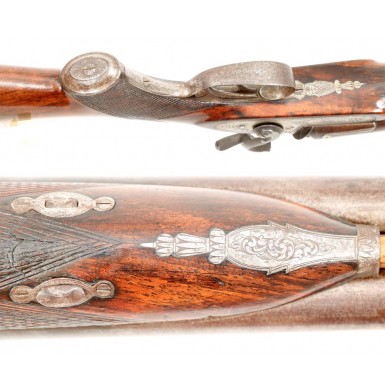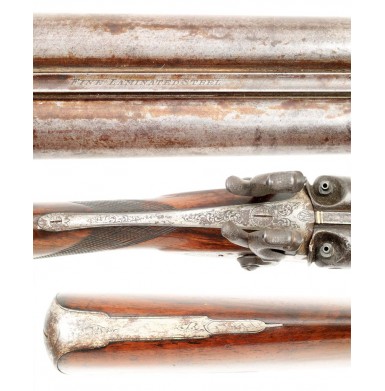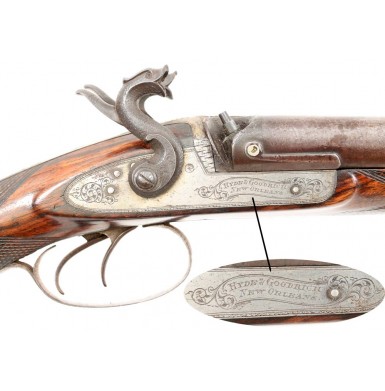Hyde & Goodrich Retailer Marked Shotgun
- Product Code: FLA-3171-SOLD
- Availability: Out Of Stock
-
$1.00
In 1816 James N. Hyde established a jewelry company in the growing city of New Orleans, LA. Hyde had been born in Norwich, CT in 1787 (or 1788 “ sources vary) and was a partner in the jewelry company Hyde & Nevins in New York City from 1812-1818. Hyde was clearly a canny entrepreneur who saw the expanding markets of United State of America as being west of the Mississippi river and so he chose New Orleans to establish his new venture. New Orleans was probably the most international city in the United States at the time and had one of the largest ports, handling cargo from around the world. European and English imports entered the city on a regular basis, while American exports (primarily raw materials such as cotton) were exported to feed the growing industrial machines of Great Britain and Europe. New Orleans was also a central location for the provisioning of those Americans who had headed west to establish new farms and homesteads and was the nearest major port to allow the export of goods raised in the newly settled areas like Texas (then part of Mexico). New Orleans commission merchants provided the capital for western ranchers and cotton growers to start their herds and plants their seeds, with the goods created by the hard working settlers promised to the merchants against these debts. As a result New Orleans became the economic center of a newly developing western expansion into territory that would one day become part of the United States. Hyde’s company was listed in the New Orleans directory of 1822 as a “Jewelry, Military & Fancy Hardware Store” located at 58 Chartres Street, and the following years simply as a “Jewelry Store” at 132 Chartres St. By 1827 the listing read “Military, Jewelry & Fancy Store” and was located at 127 Chartres Street, corner of St. Louis. This general description of the store dealing in military items, which of course included firearms, jewelry and various luxury items would typify Hyde’s company until his death, as well as its successors, into the post-Civil War era. Hyde employed his brother-in-law Charles W. Goodrich (another Connecticut transplant) in his business as the primary manager, and sometime around 1830 Goodrich appears to have starred working on his own in the same field, but at the same address. This “friendly rivalry” may have been Goodrich’s way to force the issue of becoming a partner with Hyde, and by 1832 the firm was officially known as Hyde & Goodrich. In 1838 James N. Hyde died, but the firm remained in business under Goodrich’s leadership. The firm would descend through the families of the founders with William B. Goodrich and A.L. Hyde taking the reins from their fathers and adding the additional partners of Henry Thomas Jr. and Arthur Breese Griswold. In 1861 as the American Civil War erupted A.L. Hyde withdrew from the business, and the remaining partners reorganized it as Thomas, Griswold & Company. In 1864, with the death of Henry Thomas Jr. the firm was again reorganized, and in 1865 became A.B. Griswold and Company, remaining in business under that name in New Orleans through 1924.
Although the firm of Hyde & Goodrich is heralded as one of the premier silversmiths & retailers in America during the 19th century, much of their bread and butter business was certainly along the lines of “military good” and firearms. As early as 1818 advertisements in both the New Orleans Commercial Press and the New Orleans Daily Advertiser noted such items for sale as “elegant swords, pistols, plumes &c…5 cases fowling pieces suitable, for Indian trade” and the following year an ad noted “12 cases guns, calculated fro the Indian trade”. Although the firm no doubt continued to stock arms for the fur traders, trappers and river men of the region to trade to sell to the Indians, within a couple of years the growth and prosperity of New Orleans is noted in the change of the tenor of their firearms advertising, with the Thursday January 11, 1821 issue of the Louisiana Gazette carrying the following notice:
“Fine Guns! The subscriber has received, per CRISIS, a case of extra fine fowling guns, made by Mortimer”
This advertisement not only indicates that high grade sporting arms were now part of the Hyde & Goodrich inventory, but that the guns were being imported from Great Britain as well. A July 22, 1822 notice in the same paper lists a plethora of newly arrived arms and military items, but most especially notes “Also a few English duck guns.” and in November of the same year another notice in that paper advertises: “Fine guns. Two cases of double and single barreled guns.”. Within a few years their advertisements went well beyond the listing of swords and shotguns, but also included the names of the most prominent of the American arms makers of the time as well, with one listing noting: “Rifles, Mississippi, Kentucky, Cot’s Pistols, Whitney’s, Wesson’s, Allen’s and Sharps. Sold agents for the latter in New Orleans”. The firm continued to import firearms from England as well, and by the late 1850s appeared to have developed an exclusive distributorship for Tranter’s patent revolvers within the region, as examples are known marked: W.TRANTER’s Patent HYDE AND GOODRICH / AGENTS FOR THE UNITED STATES SOUTH. As the American Civil War erupted, the firm turned their attention to providing more military goods and arms of a military nature, instead of fine English sporting guns. In July of 1861, with the change of name and the departure of A.L. Hyde, the firm sought to provide a variety of arms to the Confederacy including swords, but the effort was short lived as the Federal capture of New Orleans in the spring of 1862 put an end the company’s foray into the military arms field. These days the guns that are retail marked by Hyde & Goodrich are exceedingly rare and very desirable items for collectors of antebellum southern arms and secondary Confederate weapons. Many of the guns retailed by Hyde & Goodrich in the decades preceding the war were pressed into service with Louisiana volunteers in 1861. In fact, the large majority of the arms carried by the poorly equipped New Orleans home guard that attempted to protect the city from Federal invasion in 1862 were double-barreled shotguns, no doubt procured locally from retailer just like Hyde & Goodrich.
Offered here is one of those extra fine fowling guns that Hyde & Goodrich was pleased to announce the arrival of in the New Orleans newspapers. This is a fine quality English Double Barreled Shotgun marked Hyde & Goodrich, circa 1850-1860. Nearly all percussion shotguns in antebellum America were imported from either Belgium or England, as American makers could not produce them as cost effectively as the large gunmaking centers of Li’ge and Birmingham could. However, the typical double barreled gun imported for sale in America was a simple workingman’s firearm of utilitarian quality with little it the way of ornamentation or decoration. This gun is a tremendously higher-grade shotgun and this may well be the reason that it has survived the ages. If this was one of the many shotguns surrendered by the southerners with the fall of New Orleans, its quality alone probably insured its survival in the hands of Yankee officer who appreciated a fine gun. The gun is a double-barreled percussion 12-gauge, with 32” barrels and a 47 ““ overall length. The gun has a comfortable 13 ““ length of pull. The pair of front-action locks are neatly scroll engraved at their rears and have an engraved boarder line design around their edges. Both locks are engraved in a scroll-banner, in two lines: HYDE & GOODRICH / NEW ORLEANS. The locks have finely chased swan head hammers, and have fine detail engraving over their surfaces. The bolsters have platinum touchhole liners and a pair of gold lines are inlaid on the top of the rib between the breeches of the barrels. The top rib is engraved FINE LAMINTAED STEEL and a German silver bead is present neat the muzzle on the rib. The shotgun is steel mounted, and the mountings are engraved with a high degree of detail and precision. The triggerguard is engraved with an ornate pineapple finial to its front and the entry pipe is engraved with an equally fine urn, with tight scroll decorations. The circular patchbox is engraved with a lovely floral scroll at its center, and detailed finals to above and below. The steel buttplate and wedge escutcheons have simple engraved embellishments as well, as does the steel cap of the pistol grip. The stock is very high quality, attractively figured walnut with an elegantly executed pistol grip. The grip and wrist are neatly v-cut checkered at about 15 lines per inch with a skip line boarder. A similar checkering pattern is present on the forend as well. The bottom of the barrels are clearly stamped with commercial Birmingham view, proof and definitive proof marks, which are separated by the gauge marks. The right hand barrel is gauged 12 and the left hand barrel is gauged 13. This translates to right hand barrel that is about .729” or a typical “12 gauge” in today’s shotgun parlance, and a left that would be “13 gauge” in the 19th century but measuring about .710” is what we could call today a “12 gauge “ modified choke”. Just as with modern double guns, this find mid-19th century shotgun has a slightly tighter left barrel so that its shot will carry a little farther and still be effective.
The gun is in about FINE overall condition and appears to be 100% complete, correct and original, with the exception of the cones which are modern replacements. The gun is mechanically EXCELLENT and both locks function crisply and correctly on all positions. The hammers are both original to the gun and neither show any repairs. This is uncommon as the decorative swan head hammers are often broken during the life of the gun. The locks have a mostly smooth pewter gray patina with minor discoloration from age and some lightly scattered surface oxidation. The iron mountings have a similar appearance overall, with the some scattered patches of surface oxidation and minor discoloration present as well as some light pinpricking. The buttplate and triggerguard both shows the most age toning with a dark brownish gray patina and more patches of light surface roughness present. The barrels have a medium pewter gray patina with patches of brown that are a mixture of trace original browning and patches of surface oxidation and discoloration. The barrels are mostly smooth, with lightly scattered pinpricking and some flecks of lightly oxidized surface roughness present. There is some more moderate pinpricking and light pitting around the breech and bolster area of the caustic percussion cap flash. As noted earlier, the cones (nipples) are modern replacements. There is a minor ding in the right barrel, about 1 ““ from the muzzle. The bores of the gun are both in VERY GOOD condition and retain some of their original bright polish. Both bores show patches of darkness and are somewhat dirty, so a good scrubbing would be in order. The bores appear to show only some lightly scattered pitting along their lengths, which is moderately more pronounced nearer the muzzles. The barrels are retained to the stock with a single wedge through a single tenon and with the hooks at the breeches. Two simple iron pipes retain the ramrod, in conjunction with the entry pipe in the stock. When the gun was first photographed the lower pipe had become loose and moved about some on the ramrod. It has been firmly reattached at its correct, original position. The wooden ramrod is original and period and fits the gun so well it is likely original to the gun. It is a simple walnut shaft with a brass head and an integral jag end on the reverse with a ball puller and wiper included. The stock of the gun is in about VERY FINE condition as well and remains solid, complete and full length with no breaks or repairs noted. A surface grain crack is present between the two wedge escutcheons and runs through the forend checkering. This is non-structural and appears only at the surface. The stock remains crisp throughout and has not been sanded. All of the checkering remains crisp as well, with only some minor flattening of the sharpest edges from handling and use. The stock retains the majority of what appears to be its original varnished finish, and other than some minor bumps and dings from handling and use, remains in really wonderful condition.
Overall this is a really very attractive and high condition example of a scarce southern retailer marked shotgun from the decade immediately preceding the American Civil War. Shotguns with such prominent retailer marks as Hyde & Goodrich are uncommon and very desirable. This one is a particularly nice gun that remains in original condition and is very well marked. This would be a wonderful addition to a collection of antebellum southern arms, secondary Confederate arms or a collection that centers on such important southern retailers as Hyde & Goodrich. I am quite sure you will be very glad that you chose to add this fine southern retailer marked double to your collection.
SOLD

